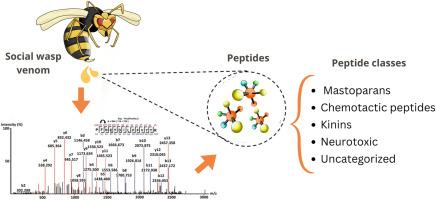From the sting to the laboratory: A review of the venom peptides of social wasps (Hymenoptera: Vespidae)
IF 2.4
4区 医学
Q2 PHARMACOLOGY & PHARMACY
引用次数: 0
Abstract
Social wasps make up a significant part to the diversity of the Hymenoptera order, one of the most varied insect groups. Beyond their ecological importance, these insects use their venom for defense, protecting their colonies. The venom of social wasps are rich in biologically active substances, including biogenic amines, peptides, proteins, enzymes, allergens, and volatile compounds. These substances can trigger various immune responses, such as allergic reactions and inflammation, and certain peptides demonstrate antimicrobial, anti-inflammatory, antitumor, anticoagulant, and anticancer properties. However, the limited availability of venom and the lack of studies of function for its bioactive compounds remain challenges to its effective utilization. This review compiles 124 peptides isolated from social wasps, highlighting their relevance in biotechnology and medicine, while also discussing their limitations and potential applications. These peptides were isolated from 39 species of social wasps worldwide, underscoring the potential of these insects' venom as a promising source for developing new pharmaceutical products and as a catalyst for drug discovery. Additionally, this work emphasizes a significant gap in research on social wasps collected in the Brazilian Amazon.

从刺痛到实验室:社会黄蜂(膜翅目:蜂科)毒液肽的研究进展。
社会黄蜂是膜翅目昆虫多样性的重要组成部分,膜翅目昆虫是最多样化的昆虫群体之一。除了生态上的重要性,这些昆虫还用它们的毒液来防御,保护它们的群落。群居黄蜂的毒液中含有丰富的生物活性物质,包括生物胺、多肽、蛋白质、酶、过敏原和挥发性化合物。这些物质可以引发各种免疫反应,如过敏反应和炎症,某些肽具有抗菌、抗炎、抗肿瘤、抗凝血和抗癌特性。然而,由于蛇毒的可获得性有限,对其生物活性化合物的功能研究不足,仍然是其有效利用的挑战。本文综述了从社会黄蜂中分离的124个多肽,重点介绍了它们在生物技术和医学上的相关性,同时也讨论了它们的局限性和潜在应用。这些肽是从全世界39种社会黄蜂中分离出来的,强调了这些昆虫的毒液作为开发新药物的有希望的来源和作为药物发现的催化剂的潜力。此外,这项工作强调了在巴西亚马逊地区收集的社会黄蜂研究的重大差距。
本文章由计算机程序翻译,如有差异,请以英文原文为准。
求助全文
约1分钟内获得全文
求助全文
来源期刊

Toxicon
医学-毒理学
CiteScore
4.80
自引率
10.70%
发文量
358
审稿时长
68 days
期刊介绍:
Toxicon has an open access mirror Toxicon: X, sharing the same aims and scope, editorial team, submission system and rigorous peer review. An introductory offer Toxicon: X - full waiver of the Open Access fee.
Toxicon''s "aims and scope" are to publish:
-articles containing the results of original research on problems related to toxins derived from animals, plants and microorganisms
-papers on novel findings related to the chemical, pharmacological, toxicological, and immunological properties of natural toxins
-molecular biological studies of toxins and other genes from poisonous and venomous organisms that advance understanding of the role or function of toxins
-clinical observations on poisoning and envenoming where a new therapeutic principle has been proposed or a decidedly superior clinical result has been obtained.
-material on the use of toxins as tools in studying biological processes and material on subjects related to venom and antivenom problems.
-articles on the translational application of toxins, for example as drugs and insecticides
-epidemiological studies on envenoming or poisoning, so long as they highlight a previously unrecognised medical problem or provide insight into the prevention or medical treatment of envenoming or poisoning. Retrospective surveys of hospital records, especially those lacking species identification, will not be considered for publication. Properly designed prospective community-based surveys are strongly encouraged.
-articles describing well-known activities of venoms, such as antibacterial, anticancer, and analgesic activities of arachnid venoms, without any attempt to define the mechanism of action or purify the active component, will not be considered for publication in Toxicon.
-review articles on problems related to toxinology.
To encourage the exchange of ideas, sections of the journal may be devoted to Short Communications, Letters to the Editor and activities of the affiliated societies.
 求助内容:
求助内容: 应助结果提醒方式:
应助结果提醒方式:


